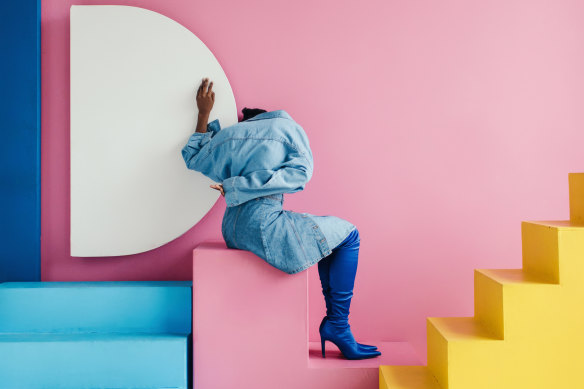This was published 1 year ago
Louise wears a different colour for each day of the week. This is why
By Evelyn Lewin
For the past 12 months, Louise Edmonds has been dressing in a different colour each day. The 50-year-old business owner finds the start of the week “daunting”. So on Mondays she wears blue, a colour she believes helps her “stay calm and focused”.
Tuesdays are all about yellow, which Edmonds finds uplifting. On “hump day”, you’ll find her in green. “I have green eyes, I love jade and emerald, so I like wearing this midweek for a sense of elegance,” she says.

The colours you wear can affect your own mood and how you’re feeling, as well as influencing how others react to you.Credit: Stocksy
By Thursday, Edmonds is ready to exude “passion and power”, which is why she opts for a striking splash of red. As the work week draws to a close, Edmonds dresses in black. Not only does she feel it adds an air of authority (helpful when people’s minds are already drifting to thoughts of the weekend), she says it also transitions well to after-work drinks.
On the weekends, Edmonds wears pink on Saturdays for a pop of fun, and white on Sundays to cultivate a sense of serenity. She doesn’t dress head-to- toe in each colour each of those days. Instead, she picks a key piece in the day’s chosen colour and works the rest of her outfit around that.
Edmonds adopted this colour system in an attempt to “streamline” her life, reducing the amount of time she spent each morning mulling over her clothing options. As a trained men’s stylist, she also wanted to utilise the “power of colour” to her advantage. Wearing colours she feels help her reach her goals, or align with the tone she wants to set, puts a bounce in her step.
Personal stylist, image consultant and author Imogen Lamport doesn’t wear a different colour each day of the week but, like Edmonds, believes in the importance of paying attention to the colours of your clothing. She says the colours you wear affect your own mood and how you’re feeling, as well as influencing how others react to you.
Lamport, who blogs at Inside Out Style, takes such factors into consideration when selecting what she chooses to don each day. When she needs to be decisive, Lamport opts for red, as she feels that colour “makes us take action”. When she wants to tap into her creative side, she wears purple, a colour not traditionally associated with the corporate world. On days she hopes to feel “calm and peaceful”, she reaches for clothing in turquoise or teal. And when she’s looking for an injection of vibrancy, she’ll add a dash of hot pink, her “happy colour”.
“Colour psychology” is often viewed as a pseudoscience, says psychologist Dr Marny Lishman. “But most people would agree, anecdotally, that colours do affect our mood.” She adds that people often identify certain feelings with particular colours. “Whether it’s green signifying nature and healing, yellow to elicit happiness, blue to signify calmness and tranquillity, or red to signify power and passion, it’s something unconscious that can shift how we feel and how others feel.”
Lishman puts “a lot of thought” into the colours she chooses to wear. When presenting talks on mental health, for instance, she opts for bright colours “to keep conversations energising and upbeat, in order to empower audiences to look after their mental health”.
That doesn’t mean we should get decked out head to toe in bright colours if we feel more comfortable in neutral tones. Instead, Lishman advises choosing colours “that make us feel the way we want to feel”. If colours make us feel good, she notes, that can have a positive effect on our mood.
Make the most of your health, relationships, fitness and nutrition with our Live Well newsletter. Get it in your inbox every Monday.